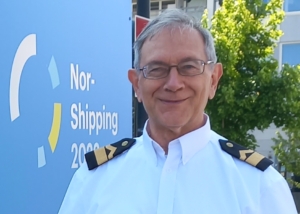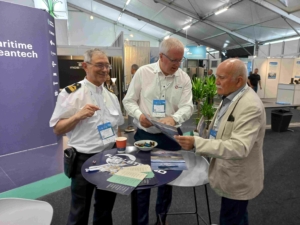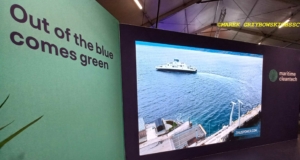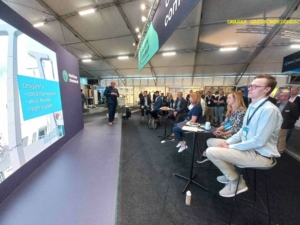Norway on a course for innovation, autonomy and decarbonization

 By Marek Grzybowski
By Marek Grzybowski
The Norwegian Maritime CleanTech cluster is an example of an efficiently operating hub setting directions for innovation in maritime transport and creating innovative solutions that are then replicated by imitators from other countries. In some cases also in Poland.
– From a commercial point of view, 2023 was an exciting year. We witnessed the introduction of marine fuel cell systems, large-scale electric drive solutions, the creation of the first ammonia-powered engine, and the activity of shipowners investing in fleets powered by the fuels of the future. These are just a few milestones from Maritime CleanTech partners, writes Ada Jacobsen, CEO of Maritime CleanTech, in the introduction to the 2023 report.

The power of Maritime CleanTech Members
Jacobsen emphasizes that innovative solutions are beginning to mature in all segments of maritime transport. “As countries and companies around the world begin to catch up with this reality, early movers will have a clear advantage in the market.”
– Shaping policy and increasing the scale of the market for ecological maritime solutions, both at home and abroad, is the basis of the new Maritime CleanTech strategy. Progress accelerates as our innovation-leading partners come together to ensure the decarbonization of maritime businesses. Together, we set the course for achieving the goal by 2030 and set the pace to follow the path towards [ecological solutions in maritime transport – MG] by 2050 – emphasizes Ada Jacobsen.
– Despite global challenges such as war, inflation and political instability, our commitment to combat climate change remains unwavering. We understand the importance of energy efficiency and cooperation in the transition to a cleaner maritime industry, notes Bjørn Sundland, Chairman of the Board, Maritime CleanTech.

From fertilizer to fuel
The ShipFC project is preparing the ship to sail with ammonia-powered propulsion. Designers are working to determine the conditions under which the ship can perform long-distance cruises without emitting harmful substances. The trials are being carried out on the Viking Energy offshore vessel, operated by Eidesvik.
The research vessel is used by Equinor. The unit is equipped with a large system of ammonia fuel cells with a capacity of 2 MW.
– Thanks to this, the ship can operate only on clean fuel. The ammonia used in the system ensures energy production based on the electrolysis process. Ammonia is an abundant source of energy and can be easily produced using energy from renewable sources, emphasize the designers of this solution.
It is assumed that ammonia may be one of the fuels that can cover part of the future demand for shipping fuels. The partners of this project are convinced of this: Maritime CleanTech, Eidesvik, Equinor, Wärtsilä, Alma, Fraunhofer IMM, Yara International, University of Strathclyde, Demokritos, Persee, North Sea Shipping, Capital Executive, Star Bulk and Sustainable Energy.

Ro-ro with sails
As part of the Orcelle Horizon project, a solution is being developed that uses wind to support ships with diesel engines. Two demonstrators are being designed and built in Norway. In the first case, one wing is modernized. The second demonstrator assumes a multi-leaf drive system. The demonstrators are car carriers (PCTC) operating ocean services.
Wallenius Wilhelmsen and project partners obtained funding worth EUR 9 million under the Horizon Europe program to support the construction of a RoRo vessel called Orcelle Wind. Orcelle Wind is a 220-meter-long wind-powered ship. Its decks will be able to transport over 7,000. cars. It will also be adapted to transport general cargo and larger vehicles. The ship will be equipped with digital systems allowing for dynamic route planning based on information about weather conditions. This will allow you to optimize your cruises and take advantage of the best wind conditions.
The success of the project is ensured by well-selected partners: Wallenius Wilhelmsen, SSPA Sweden, KTH Royal Institute of Technology, University of Ghent, Alfawall Oceanbird, StormGeo, Volvo Cars, Maritime CleanTech, NTUA, Wallenius Marine, DNV.
In addition to the demonstrator, models and tools will be developed that will be used to develop advanced conceptual designs and operational plans for other ship types. The project is being implemented with the aim of using the sails on merchant ships to use the wind as the main propulsion. Presentation of the drive idea on the website

Charging at an offshore wind farm
The Norwegian government has awarded Maritime CleanTech and Vard Group, partners of the Ocean Charger project, NOK 38 million (approx. USD 3.9 million) to develop solutions for charging ships at sea. The project is aimed at fleets operating wind farms. The idea is to achieve zero emissions from units operating on offshore wind farms.
The Norwegian support program (The Green Platform Initiative) aims to accelerate the development of ecological companies in Norway.
In December 2022, the Norwegian Minister of Trade, Industry and Fisheries, Jan Christian Vestre, launched the new project at a press conference in Oslo. He stated: “We are carrying out the largest restructuring of the Norwegian economy in history. Everything will become greener. It is private companies that must lead this transformation, with the support of the public sector.”
– The three-year Ocean Charger project started in 2023 and covers research, testing, validation and commercialization of new technological solutions for transmitting energy to battery-powered ships, such as electrically powered service vessels (SOVs), says the project leader. The designed solution allows for connecting vessels to the wind farm power grid and charging the batteries. This will enable the implementation of emission-free operation of vessels. Support was provided by: Norwegian Research Council, Innovtion Norway and Enova. Project partners are: Vard Design (leader) and Seaonics and Vard Electro, Rem Offshore, Solstad Offshore, SINTEF Energi, SINTEF Ocean, DigiCat, Sustainable Energy, Equinor, Source Energie, Corvus Energy, Plug, Shoreline, Marin Energi Testsenter, University of Bergen, Norce and Maritime CleanTech.
Rem Power is the first ship to take part in tests of the Ocean Charger project. Rem Offshore Chief Operating Officer Ronny Pål Kvalsvik emphasized the importance of the project: “It is extremely important for us to participate in the Ocean Charger project. We can show what we have been saying for years, and now we have partners who confirm it and we can prove to the market that charging the ship’s batteries at sea – MG is feasible.”


The city Haugesund will build an autonomous ferry
The autonomous and zero-emission passenger ship is a pilot project worth NOK 11 million implemented by the Norwegian city of Haugesund. Funding was obtained from Ulla-Førrefondet. The project will include the design and construction of a vessel, a floating dock for mooring the vessel and charging facilities.
The fully electric ship will be prepared for autonomous sailing. It will carry approximately 50 passengers and have a maximum speed of 15 knots. It is planned that the ship will serve connections in internal waters in Haugesund. Such a city passenger ship will shorten travel time, eliminate car traffic and reduce greenhouse gas emissions in the region – emphasize the project initiators. The project partners are: Haugesund City Council, Maritime CleanTech, Nordic Edge, SAMS, Hyke, NORCE, Western Norway University of Applied Science and Karmsund Port Authority.
– This is excellent news! We are very grateful that Ulla Førre Fond recognized the project to build autonomous passenger ships of the future as an important innovation, said Arne-Christian Mohn, mayor of Haugesund, after receiving information about receiving funding.
– The race for the first autonomous zero-emission passenger ship is on! Thanks to this financing, we have an excellent opportunity to take first place. The project is based on a thorough conceptual design and feasibility study. The implementation of this project will give the Norwegian maritime industry a huge advantage. The potential export opportunities of such zero-emission, autonomous ships are enormous on a global scale, said Ada Jakobsen, CEO of Maritime CleanTech.

ZAWAS – from Norway to international waters
The ZAWAS (zero-emission autonomous water shuttles) project was launched with the aim of introducing zero-emission autonomous water shuttles to Norway’s internal waters. The project aims to facilitate the transformation of waterways into alternative routes to land connections. These are to be fast, zero-emission and autonomous public transport journeys. In 2021, Innovation Norway has allocated NOK 5.5 million to leading Norwegian design companies and shipyards.
Innvation Norway got involved in the initiative because the product that will be the result of the project is to be Norway’s export showcase. Success in its implementation will be ensured by partners with high innovative potential: Brødrene Aa, Hydrolift Smart City Ferries, Maritime Robotics, Masterly, Zeabuz, ZEM, SEAM, Advokatfirmaet Simonsen Vogt Wiig, Applied Autonomy, Blueday, NHH, Maritime CleanTech, SAMS Norway and Nordic Edge.
– Thanks to solid funding, the industry and clusters received the opportunity to cooperate in the development of water trams of the future as part of the ZAWAS project (zero-emission autonomous water ferries) – emphasizes the investor. The promotional effect of the project is important. It is emphasized that “ZAWAS is a project aimed at showing how automated and autonomous passenger ferries can be a breakthrough in the development of a future zero-emission mobility system.” It goes without saying that the aim was also to help Norwegian industry and related service providers gain a leading international position in the development and supply of autonomous zero-emission passenger ships to the international market.



In Norway, every maritime cluster runs many initiatives
related to introducing innovations in maritime industries. Projects related to the development of ocean and fjord shipping, the production of fish farms and the development of offshore wind farms and offshore oil and gas are being developed. The work is carried out at many levels and in various locations. Not only the government is involved in the projects. Voivodeships, municipalities and cities are involved in supporting innovation. Support is provided to clusters and groups of enterprises and universities, design companies and research institutions.
These other projects implemented in Maritime CleanTech cluster companies aim to maintain the pace of innovation in maritime transport and generate a competitive advantage in the maritime transport market. The mentioned projects are only some of the initiatives that are implemented in Norwegian maritime clusters.
As a result, a synergy effect is created, where administration, research centers and industry lead the way in positioning innovations. First in Norway, then on the international market. Polish partners are invited to some implementations. Unfortunately, as subcontractors. This proves the good level of our production potential. Unfortunately, this does not reflect well on our design and cooperation potential and on building competitive advantage based on innovation.
sources: Maritime CleanTech, Fraunhofer, ZAWAS, Vard Group, Wallenius Wilhelmsen, Ulla-Førrefondet
